
Bold pathways point to a low-carbon
future
Jul 11, 2014 - Alex Kirby - climatenewsnetwork.net
 |
Brighter future? Sunrise over
a wind farm in the Cambridgeshire Fens, UK
Image: David Clare/Climate News Network |
The positive message from a scientific report
for the UN Climate Summit is that the tough task
of cutting
CO2 emissions to limit global temperature rise to
below 2°C is definitely achievable by following
a set of bold, practical steps.
LONDON, 11 July 2014 - Scientists often hesitate
to give a cut-and-dried, yes-or-no answer when asked
how serious climate change is going to be, and whether
the world can still escape significant damage.
Surprisingly, perhaps, a report prepared for a UN
conference in September is unequivocal. Yes, it says
- the worst is not bound to happen.
The good news is that the world can keep climate
change within what are thought to be acceptable limits.
The less good news is that while it is possible,
it certainly won’t be easy.
The report shows how the countries that emit the
most greenhouse gases (GHGs) can cut their carbon
emissions by mid-century to prevent dangerous climate
change. Prepared by independent researchers in 15
countries, it is the first global co-operation to
identify practical pathways to a low-carbon economy
by 2050.
The Deep Decarbonisation Pathways Project (DDPP)
report is an interim version prepared for the UN
Climate Summit to be held in New York on 23 September.
The full DDPP report will be ready in the spring
of 2015.
Dangerous change
The UN Secretary-General, Ban Ki-Moon, said the
report tried to show how countries could help to
achieve the globally-agreed target of limiting temperature
rise to below 2°C. “Ambitious national
action is critical to averting dangerous climate
change,” he said. “This report shows
what is possible.”
The report aims to help countries to set bold targets
in the run-up to the UN climate talks to be held
in Paris in 2015.
The work is led by the Sustainable Development Solutions
Network (SDSN), an initiative of Columbia University’s
Earth Institute for the UN, and the Institute for
Sustainable Development and International Relations
(IDDRI), a policy research institute based in Paris.
Jeffrey Sachs, the director of the SDSN, said the
world had committed itself to limit warming to below
2°C, but not to practical ways of achieving that
goal.
He said: “This report is all about the practicalities.
Success will be tough – the needed transformation
is enormous – but is feasible, and is needed
to keep the world safe for us and for future generations.”
“The issue is to convince the world
that the future is as important as the present”
Fatih Birol, chief economist of the International
Energy Agency, said: “The issue is to convince
the world that the future is as important as the
present. Paris 2015 may well be our last hope.”
Despite the global agreement to stay below 2°C,
the world is on a path that, without action, will
lead to an increase of 4°C or more. The Intergovernmental
Panel on Climate Change said in its Fifth Assessment
Report, known as AR5, that such a rise might exceed
the world’s ability to adapt.
It said that a 4°C rise could endanger harvests
and cause drastic sea-level rise, spread of diseases,
and the extinction of ecosystems.
Some leading climate scientists - including NASA’s
former chief climate scientist, Professor James Hansen,
who is now at Columbia University - say that even
a 2°C rise would be very dangerous. But many
politicians regard it as an essential commitment.
The 15 national pathways examined in the report
all show the importance of three factors for achieving
radically lower carbon emissions.
The first is greatly increased efficiency and conservation
in all energy use.
Renewable sources
The second factor is taking the carbon out of electricity
by using renewable sources, “such as wind and
solar, as well as nuclear power, and/or the capture
and sequestration of carbon emissions from fossil-fuel
burning”.
Nuclear energy still attracts widespread and determined
opposition, and carbon capture and sequestration
(trapping CO2 emissions and storing them underground
or beneath the sea floor) has not yet proved that
it can work on a commercial scale.
The third factor involves replacing fossil fuels
in transport, heating and industrial processes with
a mix of low-carbon electricity, sustainable biofuels,
and hydrogen.
The authors say their interim report shows the critical
long-term importance of preparing national deep decarbonisation
plans for 2050.
Emmanuel Guerin, the DDPP’s senior project
manager, said the pathways were crucial to shaping
the expectations of countries, businesses and investors.
- Climate News Network

|


